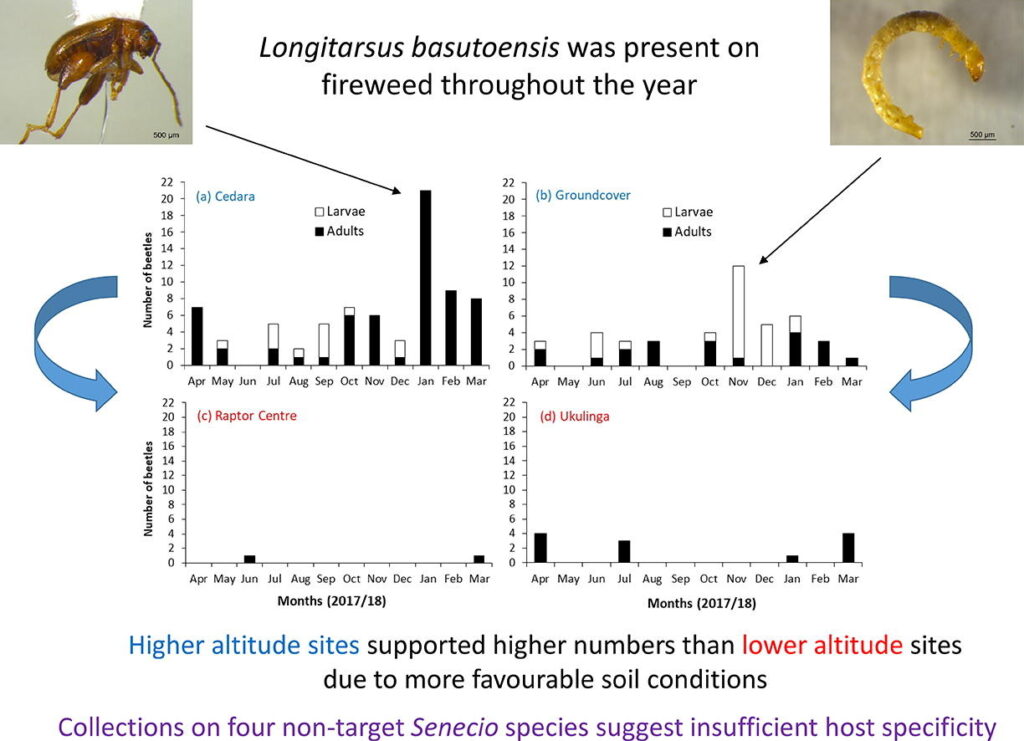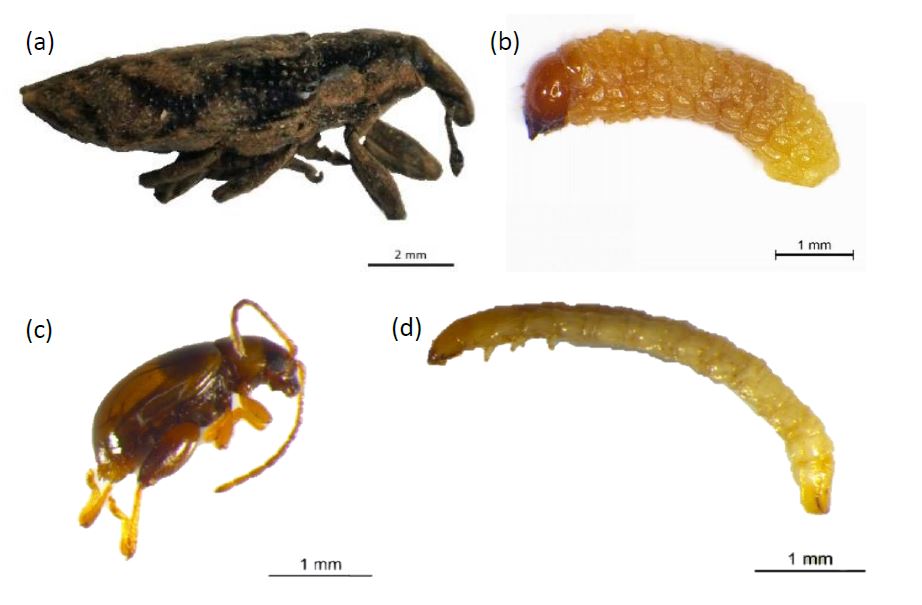Previous Research (2016-2019)
Soil-dwelling flea beetle, Longitarsus basutoensis
Previous research by the CSIRO sought to discover biological control options for fireweed in South Africa, with a focus on insects that attack fireweed’s stems and root system. Extensive field surveys across southern Africa identified a soil-dwelling flea beetle (Longitarsus basutoensis, whose larvae feed on fireweed’s root system) as the most promising candidate biocontrol agent for testing. The field research also sought to determine the seasonal abundance and host plant associations of the flea beetle throughout southern Africa.
Researchers from the University of KwaZulu-Natal (Dr Terry Olckers and Dr Dani Egli) were engaged to perform host-specificity testing to determine if the flea beetle could feed and develop on representative Australian native plant taxa from the genus Senecio. Host-specificity testing involved exposing adult flea beetles to the non-target plant species and the preferred host fireweed plant (experimental control), allowing the flea beetles to mate, lay eggs and larvae to develop to adulthood by feeding on the plants’ root systems.
These tests revealed the presence of late-instar L. basutoensis larvae around the roots of several non-target plant species, including a variety of the Australian native plant Senecio pinnatifolius, that cooccurs with fireweed in south-eastern Australia. Longitarsus basutoensis was thus considered unsuitable for importation into Australia, since it appears to be an oligophagous species that, despite a relatively narrow field host range, may attack native Australian Senecio species with similar pyrrolizidine alkaloids to S. madagascariensis. Upon consultation with regulators and expert entomologists specialising in weed biocontrol, it was decided to discontinue research on the flea beetle and not seek permission to release it into the Australian environment.

Detailed results from the flea beetle tests can be found here: Zuma, O., Egli, D., Gooden, B. and Olckers, T., 2021. Seasonal abundance and host-plant affinities of Longitarsus basutoensis and related flea beetles associated with the invasive Senecio madagascariensis in their native range in KwaZulu-Natal, South Africa. Biological Control, 160, p.104681.
Stem-boring weevil, Gasteroclisus tricostalis
Previous genetic analyses (undertaken in parallel to the host-specificity for the flea beetle) revealed a second candidate agent with a narrow field host range to fireweed in South Africa: the stem-boring weevil Gasteroclisus tricostalis.
Detailed results from the genetic analyses can be found here: Singh, D., Egli, D., Willows-Munro, S., Gooden, B. and Olckers, T., 2022. Seasonal abundance of stem-boring insects associated with the invasive Senecio madagascariensis in its native range (KwaZulu-Natal, South Africa) and their potential for biological control. Biocontrol Science and Technology, 32(5), pp.607-623.
Prioritised list of candidate biocontrol agents for fireweed (April 2019)
Based on the outcomes of the previous research that concluded in 2019, the following candidate agents (and activities) were prioritised for future research (noting exclusion of the flea beetle L. basutoensis):
| Priority | Species | Feeding guild | Future research activities |
| 1 | Gasteroclisus tricostalis (Coleoptera: Curculionidae) | Stem borer | Determine life cycle; develop lab-reared colony; assess damage to fireweed; undertake preliminary host-specificity testing on South African and Australian native Senecio species to justify importation to Australia for further risk analysis. |
| 2 | Metamesia elegans (Lepidoptera: Tortricidae) | Stem borer | Develop culturing technique; determine life cycle; develop lab-reared colony; undertake preliminary host-specificity testing on South African and Australian native Senecio species to justify importation to Australia for further risk analysis. |
| 3 | Homeosoma stenotea (Lepidoptera: Pyralidae) | Capitulum feeder | Resolve host range using genetic barcode analysis of capitulum-feeding pyralid larvae. If sufficiently host specific: develop culturing technique; determine life cycle; assess impacts on fireweed seed production; undertake preliminary host-specificity testing on South African and Australian native Senecio species to justify importation to Australia for further risk analysis. |
| 4 | Trupanea sp (Diptera: Tephritidae) | Capitulum feeder | Determine species identity using a combination of morphological and molecular analyses (likely two undescribed species). |
| 5 | Lepidoptera: Pterophoridae (indeterminate genus and species) | Stem-borer, capitulum feeder | Determine species identity using a combination of morphological and molecular analyses (likely an undescribed species). |

Priority insects: a-b, stem-boring weevil Gasteroclisus tricostalis; c-d, root-feeding flea beetle Longitarsus basutoensis.
